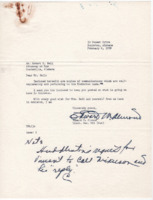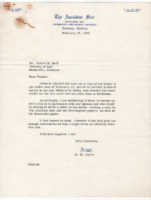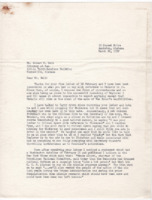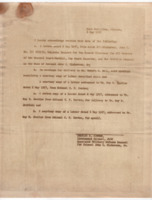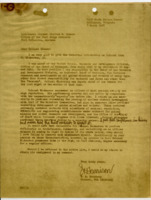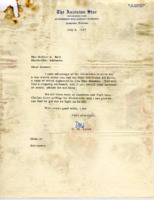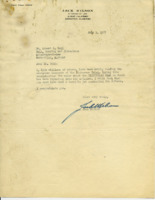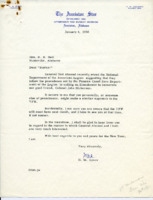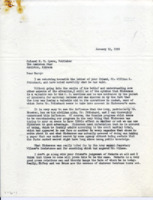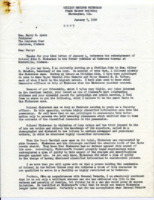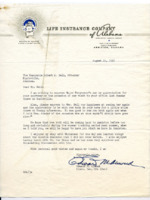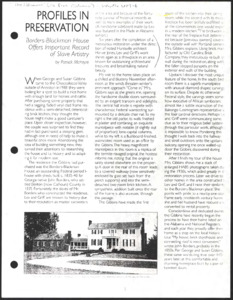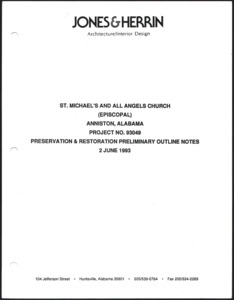
Browse Items (13 total)
Sort by:
-
Correspondence between Robert K. Bell and Edward M. Almond.
These letters include information pertaining to the Nickerson case. Almond expresses desire to "get something in motion to subdue the unnecessary and trivial expressions of � General Medaris". The letters also mention various correspondence that was included in the exchange of information. Both men advocate for the "cause" of Colonel Nickerson's actions. Bell was Nickerson's attorney during his trial. -
Correspondence between Robert K. Bell and Harry M. Ayers.
In response to Bell's February 13 letter from Edward Almond, Ayers informs Bell that he is attempting to find someone who would write a letter to newspaper publications in agreement with their opinion that Medaris is taking too much credit for his work. Bell responds that he is skeptical Ayers would find anyone as Medaris could make their life a "rather miserable existence". -
Letter to Robert K. Bell from Edward M. Almond.
Almond writes in reponse to Bell's February 18 letter regarding Medaris and other information of the Nickerson case. -
Acknowledgment of receipt of documents from John C. Nickerson, Jr. to Charles R. Zimmer.
This letter acknowledges the receipt of a letter, an envelope for delivery, two courtesty copies, and a carbon copy of various letters. -
Letter to Lt. Col. Charles R. Zimmer from E. H. Harrison.
Harrison writes of Nickerson's character throughout the letter. He states that if he ever returned to the active list, he would try to obtain "his assignment to my command." -
Letter to Robert K. Bell from Harry M. Ayers.
Ayers writes to Bell about an article written in The Anniston Star about him and the Nickerson trial and congratulates Bell for getting Nickerson "out as light as he did." -
Letter to Robert K. Bell from attorney Jack Wilson.
Wilson writes to Bell to congratulate him on the Nickerson case and states that he has been "avidly reading the newspaper accounts of the Nickerson trial" but still believes that Bell did a "terrific" job defending Colonel Nickerson. -
Letter to Robert K. Bell from Harry M. Ayers.
Ayers writes regarding a wire from General Edward Almond to the National Department of the American Legion "calling on Eisenhower to exonerate our good friend Colonel John Nickerson." -
Letter to Harry M. Ayers from Edward M. Almond.
Almond writes to Ayers stating that he believes Nickerson is still a "valuable man to the U.S. services" and thanks Ayers for his interest in the matter. -
Letter to Harry M. Ayers from William S. Pritchard.
Pritchard writes to Ayers in response to his January 4, 1958 letter regarding the reinstatement of Colonel John C. Nickerson, Jr. He details what he believes to be "the exact facts in the Nickerson case." He states that Nickerson was in violation of Army orders and therefore is not qualified to serve in a facility like Redstone Arsenal in Huntsville, Alabama. -
Letter to Robert K. Bell from Edward M. Almond.
This letter thanks Bell for the courtesy extended to Almond and Major Fergusson's visit to his office and expresses well wishes to Bell's wife. Almond details a few aspects of his stay in Huntsville in this letter. -
Architecture notebook 26: Borders-Blackman House, in Anniston, Alabama.
Borders-Blackman House, built c. 1840. Late-Federal period "I" type house. Located north of Anniston, Alabama. The master carpenters who built the residence, Lev and Griff, were enslaved to John Borders, the first resident of the home. -
Architecture notebook 62: St. Michael's & All Angels Episcopal Church, at 1000 W. 18th St., Anniston, Alabama.
St. Michael's and All Angels Episcopal Church, built c. 1888 by John Ward Noble. Selected as a state historical site. Preservation included stain glass windows, interior, exterior, and other various details on the property. Located at 1000 W. 18th St., Anniston, Alabama.
